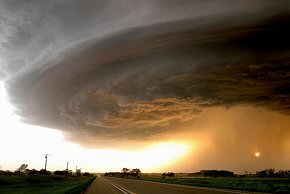
The U.S. Department of Energy has just announced the launch of IMPACTS – Investigation of the Magnitudes and Probabilities of Abrupt Climate Transitions – a program bringing together six national laboratories to ponder the likelihood of abrupt climate change (ACC). Argonne, Los Alamos, Lawrence Berkeley, Lawrence Livermore, Oak Ridge, and Pacific Northwest are the participating national laboratories.
IMPACTS principal investigator William Collins, of Berkeley Lab’s Earth Sciences Division, points out that climate change has occurred with frightening rapidity in the past and will almost certainly do so again. He cites the reverse hiccup in a warming trend that began 15,000 years ago and eventually ended the last ice age. Roughly 2,000 years after it started, the warming trend suddenly reversed and temperatures fell back to near-glacial conditions for over a thousand years. Then the warming resumed so abruptly that global temperatures shot up 10 degrees Celsius in just 10 years.
The IMPACTS team will initially focus on four types of ACC:
- instability among marine ice sheets, particularly the West Antarctic ice sheet;
- positive feedback mechanisms in sub-arctic forests and arctic ecosystems, leading to rapid methane release or large-scale changes in the surface energy balance;
- destabilization of methane hydrates (vast deposits of methane gas caged in water ice), particularly in the Arctic Ocean; and
- feedback between biosphere and atmosphere that could lead to megadroughts in North America.
Collins believes that more accurate computer modeling is the key to making accurate predictions. “Detailed models of processes that have been included only roughly, if at all, in [previous] climate models – the effects of methane on sunlight, for example, which has never before been incorporated, or the role of vegetation in moisture exchange between soil and atmosphere will [help] make very robust predictions.”
Collins says that the 30-year quest to make climate models truly comprehensive has only recently met with success. “We used to build in the carbon cycle by telling the model how it would work – but we’ve learned that we can’t assume that; the carbon cycle is extremely sensitive to even relatively small changes in temperature and rainfall. We’ve only recently been able to simulate vegetation; we used to model forests by just placing them into the model arbitrarily – now we allow them to grow themselves. Much of this is possible because of DOE’s huge contribution to climate modeling through supercomputers,” he explained.
One of the great benefits of IMPACTS, in Collins’s view, will be to bring together parts of the climate community whose communication has traditionally been poor. For scientists concerned with the effects of climate change and those concerned with modeling it, “the working relationship hasn’t been there,” says Collins.
Related:
Climate “Tipping Points” Identified
Academics Mull Flow-On Effects Of Climate Change
Chill Out… And Fight!
West Antarctic Ice Sheet Gets Climatologists Hot And Bothered
More about the DOE’s Climate Change Prediction Program








Comments are closed.